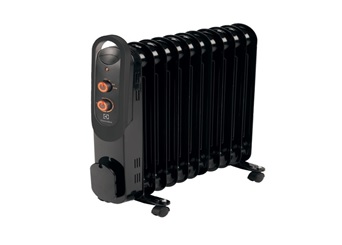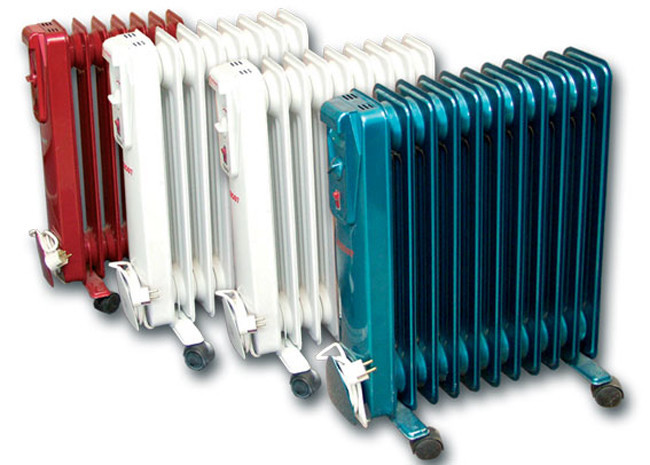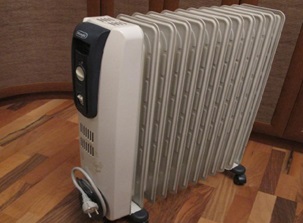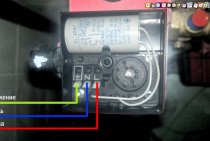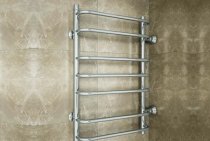Oil heater device
To use the heater correctly and carefully, it is necessary to understand at least the general principles of its design. Oil heater device
Oil heater device.
Oil heaters are known to everyone since childhood. At one time it was the most popular option for obtaining additional heat in the room. However, over the past decades, the situation has changed, and various models of such equipment with more complex designs and increased safety performance are presented on the modern market. It is the simplicity of the design that causes a large number of fakes or simply low-quality devices on the modern market. It is much easier to make such a device than other types of heaters.
If desired, even a schoolboy who understands physics can make an oil heater. Therefore, it is better to go to a store with a good reputation for such a device, rather than buying dubious imported equipment from your hands. In addition to this basic equipment selection rule, stick to two more.
First, pay attention to the marking of the device. She shouldn't be in any doubt.
Some fake manufacturers simply print the logo of a well-known brand and stick it on the box. Such marking immediately catches the eye and looks very doubtful.
Oil heater control panel.
Secondly, when studying the operating instructions for the device, pay attention to the period of its operation, which is indicated there. Usually it's 5 or 7 years old.
Longer term is less common. Be prepared for the fact that you will use the heater during this period and not a day longer.
Otherwise, the likelihood that it will explode increases significantly. Don't skimp on this equipment. This is fraught with large material losses in the event of a fire. A heater that has served you throughout the entire declared service life must be discarded. Before that, it is recommended to damage it so that no one else has the opportunity to use a potentially dangerous device.
Selection rules
Choosing an oil heater is not easy due to the variety of models, which is more of a plus than a minus. In order not to be mistaken and to purchase the model most suitable for a particular case, you should decide in advance on some parameters, the main of which is the power of the oil heater in kW.
| The area of the room planned for heating, | Sufficient heater power, kW |
| 5–10 | 0,5–1 |
| 10–15 | 1–1,5 |
| 15–20 | 1,5–2 |
| 20–25 | 2–2,5 |
For independent calculations, it is enough to take the following information as a basis: 10 sq. m of area require about 1 kW of device power for heating, provided that the ceiling height is not higher than 2.75–3 m. The higher the power of the device, the more efficiently the room is heated, but at the same time the electricity bill increases. The above table only shows the balance between the thermal effect and the lowest cost to achieve it. It is irrational to use an oil radiator to heat a larger area - sufficient heating does not occur, the air cools down before it reaches the far corners.
If you want to increase the heating rate (or the heated area), it is recommended to buy an oil heater with a fan - the circulating flow of warm air will quickly reach remote areas.
The next important parameter for selection is the number of sections in the radiator, the larger it is, the higher the heat transfer. For large rooms, more bulky models are suitable, for small ones, a few sections are enough.
Overview of models.The products of the Delonghi company, which specializes in the production of household appliances, heaters and heating elements for them, are in demand. For example, the Delonghi Radia STRRS1225 oil cooler is suitable for heating large areas - up to 75 sq. m, equipped with a thermostat and a system that allows you to increase efficiency by 35%. This option is expensive - its cost is 12 thousand rubles. The cheaper Delonghi GS770920 worth 3 thousand has 9 sections and three power levels: anti-freeze function, normal and intensive heating.
You can buy an oil flat heater "Luch" for 1 thousand rubles, its power is only 0.5 watts. SCARLETT products (scarlet) cost from 2.5 thousand rubles. SCARLETT SC-OH67B01-9 has 7 sections, power 2 kW and is designed for heating 20 sq. m.
Rules for the operation of oil heaters are described in the instructions for specific models:
- do not disassemble the case - oil leakage will lead to its ignition and fire;
- it is not recommended to dry things on the case;
- do not use the appliance in wet rooms (bathroom or shower room), for these purposes special models are produced with built-in protection against wet vapors;
https://youtube.com/watch?v=VDV1iQfTqvY
WATCH VIDEO
The oil radiator has good performance, it is safe and reliable, so it is recommended to have such a heater in the house or in the country house as an additional source of heating. It serves for about 5 years.
Design and principle of operation
The design of the oil cooler is quite simple. It consists of a housing filled with oil and one or more heating elements. The heater is controlled by an existing regulator. It allows you not only to turn the device on or off, but also to adjust the intensity of work. Modern models of oil heaters can be additionally equipped with:
- fan;
- timer;
- remote control.
Read more about inverter heater here.
The principle of operation of an oil heater is as follows: heating elements immersed in oil are heated, as a result of which the temperature of the filler rises, which transfers heat to the room through the body. Due to the fact that the heating elements are cooled in oil quite quickly, oil heaters have a high efficiency. Many modern models of oil heaters are equipped with built-in fans. With their help, a faster rate of heating of the room is provided.
Oil coolers are quite reliable, but still they can break too. Breakdowns are different, but one of the most common is an oil leak. In the event of such a malfunction, it is necessary not only to eliminate the leak, but also to add oil to the heater.
Oil heater pros and cons
Which heater model is better can be decided only after analyzing the characteristics, prices and correlating the information with your own needs. Over the years of existence of oil types of heaters, they have earned a good reputation due to a number of advantages:
Electric domestic oil heaters have their drawbacks, due to which they have not become universal heaters in houses and apartments. Among the minuses of the devices are the following:
- the inertia of the radiator - it heats up for a long time: first the oil, then the metal case, and only after that the air in the room is heated. Therefore, if the task is to quickly warm up the room, you will have to look for another type of heater;
- an oil heating radiator has a lower efficiency than other types, such as convectors or IR emitters. The device spends a lot of energy on heating itself, so the efficiency is 20–25% lower;
- The "solid" weight and volume of the device makes the electric oil heater cumbersome and inconvenient to carry from one room to another, despite being equipped with casters. It takes up a lot of space in the room, especially if the number of sections is 8-10;
- clicks and noise effects during heating, due to the movement of oil and the expansion of the metal, cause inconvenience.
Despite these disadvantages, the rating of the device among consumers remains high. An oil heater costs an average of 2500 rubles.
Technical Parameters of Oil Appliance
During operation, some important requirements must be observed. The device must be stable, the cord must not be taut. Install in a place inaccessible to children or protect it. Avoid moisture. Do not operate near flammable materials. Do not operate after service life has ended.
Compliance with such rules will allow this useful device to work for a long time and bring joy to its owners.
If your heater exploded, then most likely the responsibility for this lies with you. Although an oil heater may not be the safest option for a home, it is not likely to explode if you follow all basic operating rules and adhere to safety measures. The troubles that can happen with an oil heater are leaks, stoppages and explosions, which can start a fire, damage your property, health, or threaten your life and the lives of your loved ones.
Oil heaters are silent and more efficient at heating, but their surface is very hot.
It is worth considering the fact that not only a cheap Chinese device can explode, but also a product of well-known manufacturers. Therefore, the most important rule that will allow you to avoid an oil explosion: choose heaters carefully and responsibly.
Operating rules
After the leak in the oil cooler housing has been fixed and the oil has been filled in, special attention should be paid to the rules for its operation.
When operating heaters, the following rules should be observed:
- heaters should not be used in rooms with high humidity, for example, in a bathroom;
- the device must always be in a vertical position;
- do not use an extension cord when connecting, as it may overheat during operation;
- do not store an oil heater in a shed or on a balcony, otherwise it can quickly fail;
- the heater from various fusible products should be located at a distance of at least 50 cm.
Read more about infrared heaters here.
By following all the requirements listed above, you can be sure that the oil heater will last for a long time.
Changing the oil in an oil heater is not a very complicated procedure that you can do yourself. To do this, you just need to follow the recommendations. By doing everything right, you can extend the life of this heating device.
Due to interruptions in heating, the temperature in the living room may drop. To raise it, various heaters are used, including oil heaters with a fairly high efficiency. The latter has a number of advantages, since the principle of operation of an oil heater can leave the humidity of the air almost unchanged. The industry produces a wide variety of heaters, they have different characteristics, capabilities and design features. By getting to know them better, you can choose the right one for a particular living space.
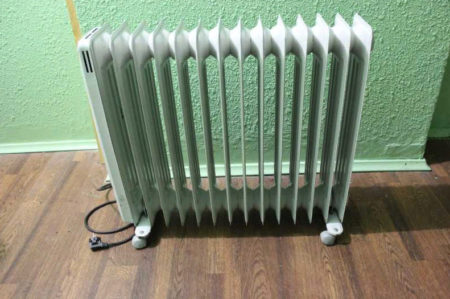
Oil cooler design
The device heat heater consists of mechanical and electrical parts. The main and largest element is a metal container containing mineral oil. According to the appearance of these tanks, the heaters are divided into:
Panels have a flat shape without cutouts and can be installed both on the floor and on the wall. To do this, the manufacturer can supply the device with special mounting devices.Compared to sectional ones, panel ones are made larger in order to obtain the same power. Sectional consist of segments of the same type, assembled into one design. They are designed to be mounted on a vertical surface. The more sections a heater contains, the more heat it can produce and therefore more power.
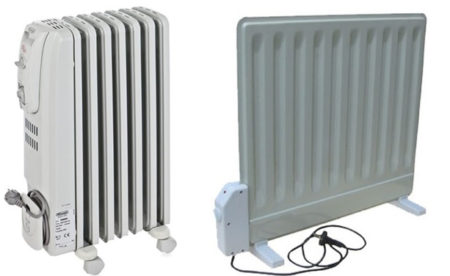
The tank can be equipped with a safety valve, it protects the tank from dangerous pressure. A tubular electric heater (TEH) is mounted in the lower part of the tank; it heats the oil to the required temperature. In addition to the heating element, the scheme includes the following elements:
- fuse;
- thermostats;
- signal lamp;
- power switch;
- fan;
- rollover protection.
All electrical elements, except for the heater, are located on the cover. The fuse makes the electrical circuit safe by protecting it from short circuits, located near the input of the power cord. An LED is used to signal the operation of the device, there may be several, depending on the additional purpose. The power switch is presented in the form of a toggle switch, when using manual control, or a variable thermostat in an automatic device.
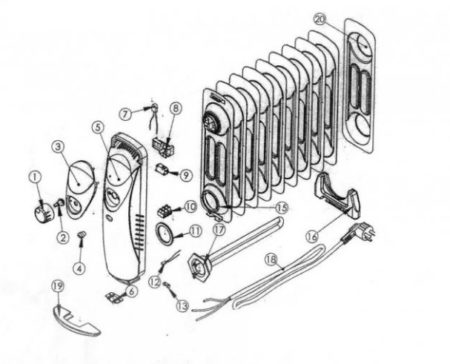
The temperature is controlled by a thermostat. How is it arranged? This device consists of a bimetallic plate and contacts. The plate is assembled from two metals with different coefficients of expansion. When heated, one part of the plate expands more than the other, and the strip is deformed. This property is used to switch the contacts of electrical devices, when heated, the plate bends and presses on the insulating support of the contact, separating it. When cooling, it assumes its previous position, connecting the contact.
If such a plate is moved away from the contact, then operation will occur at a higher temperature. The plate is heated from the tank itself, since the thermostat is in close proximity to it, and from external air through the body on which it is located.
In some devices, manufacturers install a fan, which increases heat transfer, which leads to an increase in speed and uniform heating of the room. An important device is the rollover protection. It consists of two contacts, one fixed, the other movable, located on an eccentric plate.
Principle of operation
As an element for heating, a heating element for an oil heater with a power of 1–2.5 kW is used. A heating element is a spiral heated by electricity and sealed into a tube - hence its name, which stands for tubular electric heater. It is placed in an oily viscous liquid, which is enclosed in a metal housing that is resistant to aggressive chemical environments. Connected to a 220 W network, the heating element first heats up itself, then the temperature of the oil rises, and from it - the metal case. Modern models are equipped with useful devices that perform additional functions:
- oil cooler thermostat prevents overheating,
- the fan increases the rate of heat distribution throughout the room;
- the thermostat for an oil heater helps to set one of several possible modes.
